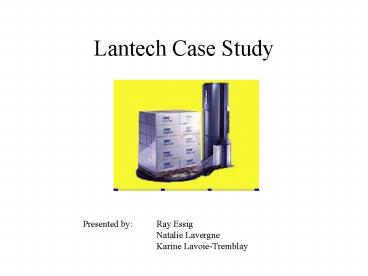Lantech Case Study PowerPoint PPT Presentation
1 / 15
Title: Lantech Case Study
1
Lantech Case Study
Presented by Ray Essig Natalie
Lavergne Karine Lavoie-Tremblay
2
Background Information
- Lantech is a Kentucky based wrapping machine
manufacturer - saved from the brink of bankruptcy by multiple
Kaizen events - Kaizens have resulted in increased productivity
and profitability - went from 50 employees turning out 8 machines/day
to 20 people turning out 14 machines/day - order processing time went from 5 wks to 14 hrs
- sales increased by 3 1/2 times
3
Abstract
4
The Kaizen Process
- Kaizen means continuous, incremental
improvement in an activity, to create more value
with less waste. - A Kaizen Event is a process that a company
orchestrates to try to improve their specific
manufacturing operations. - Carried out in a real time enviroment
- Held towards end of improvement process
5
(No Transcript)
6
- Team should include
- workers who work in current system
- workers who will work in new system
- experienced kaizen facilitators
- management who can implement changes
- Steps
- problem identification
- gather information
- analyze information
- determine root cause
- generate ideas to solve problems
- utilize simulation software
- implement agreed upon solutions
- check results
7
Assumptions
- In order to be able to perform an analysis of the
Lantech systems, some assumptions had to be made
where actual data was not available - the same assumptions were used in all 4 analysis
techniques
8
Queuing Theory
- Utilized following equations to improve
throughput time - P(0) Probability system is empty 1- ?
- Wq expected time in line ?/?(1-?)
- L time in system ?/(1-?)
- W Total time in system 1/?(1-?)
- Where ? ?/c? , ? average arrival rate, c
number of servers, and ? average service rate. - Current Gear drive assembly takes 6 hours
- 1 machine, 6 hours, 1.5 machine, 9 hours.
- Current Demand is 1.5 / 8 hour day
- Using queuing theory, reduced throughput time to
1 machine, 5 hours
9
Queuing Theory Results, before Kaizen
10
Queuing Theory Results, after Kaizen
11
Flow shop sequencing
- Created a precedence structure and sequence the
departments accordingly 38 gain in efficiency
from original case - Multi-task resources in addition to the
precedence structure 69 gain in efficiency from
original case
12
Facility Layout
- Built a REL chart
- TCR based on new layout 33 savings on total
flow cost
13
ProModel Analysis
- Several analyses were run using ProModel
- limiting factor on analysis was model size
- ProModel helped identify areas of bottleneck
where re-allocation of resources could improve
throughput - specifically areas with high cycle
time
14
Discussion
- 4 different tools Queuing Theory, Flow shop
sequencing, Facility Layout and Pro-Model. - Each tool improves a different element of the
Lantech manufacturing system - total flow cost
- resources
- throughput time
- layout
- sequencing
- efficiency/profitability
15
Conclusion
- A company initially needs to identify which
elements of their system they would like to
optimize. - The company should then proceed to use a
combination of the different tools in order to
maximize their respective strengths and provide
an overall system benefit.

